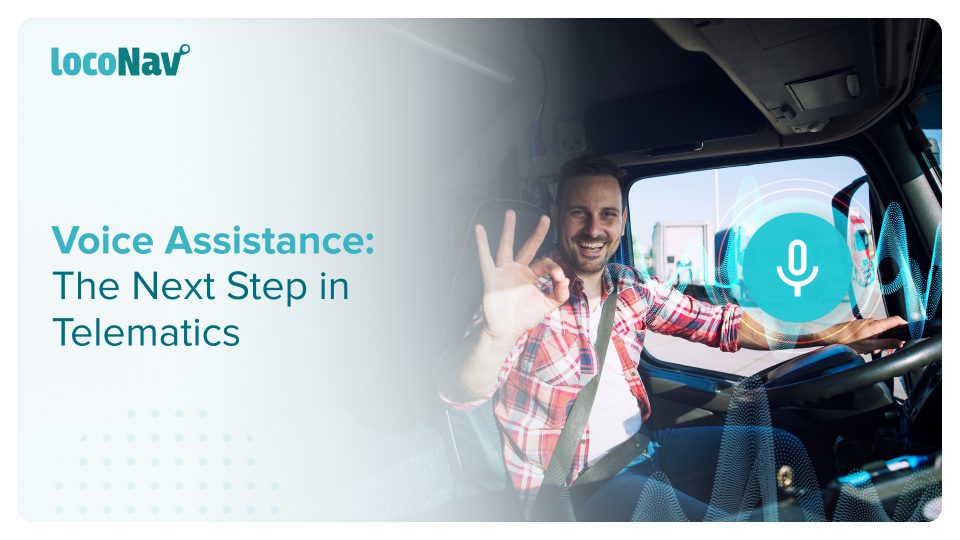

Ok Google, what’s the weather like today? Hey Siri, call Mom. Are you guilty of using your phone’s voice assistants for every little thing? Our reliance on voice assistants is undeniable. With the increasing involvement of voice assistants in our life, the natural progression for automobile manufacturers is to enable cars to incorporate voice assistant technology too.
Given that the long-term vehicle roadmap includes various degrees of autonomous driving, and improved customer engagement experience is a must. Voice assistants are at the foundation of a completely new set of consumer expectations, and automakers are fighting tooth and nail to match those expectations and revolutionize the driving experience.
Voice Assistant Telematics is the next stage of autonomous driving and a new revolution in the telematics industry. Let’s understand some of its basics and key features.
What is Vocal Assistant Telematics?
A voice assistant, as the name implies, combines voice recognition, and with Artificial Intelligence (AI) to provide assistance to users. Typically, the assistant responds to voice requests and provides the necessary information. It can address your concerns, make phone calls, and play music, among other things. With a voice command, you may even start your car or control your AC, radio, or other gadgets. Several cars have already used essential voice assistance with capabilities such as reverse and route direction.
In the future, it will be one of the must-have features when purchasing a vehicle. The main advantage of using a voice assistant in telematics is that you don’t have to move your hands while driving. It allows drivers to focus on the road, ensuring everyone’s safety. That means there are fewer chances of a mishap occurring. When a collision happens, voice alerts in systems such as the Advanced driver assistance system will warn the driver.
Telematics technology in vehicular technologies and how it aids in the monitoring of vehicles, engine diagnostics, vehicle, and driver behavior. The addition of vocal assistant telematics is the cherry on the cake.
How are Voice Assistants Evolving Technology for Driving Experience?
Many advances in telematics and voice recognition have been motivated by the desire to ensure public safety while also embracing a device-dependent culture. This is particularly true when it comes to automobiles. Whether it’s a text message or using Google Maps, the desire to look away from the road has become automatic.
In-car voice recognition technologies are already nearly standard in the majority of new vehicles on the market. However, while safe driving practices (and in many countries, the law) demands us to ignore incessant calls, mails, and texts while behind the steering wheel, this isn’t always the case. The goal of in-car speech recognition systems is to eliminate the distraction of glancing down at your phone while driving. A heads-up display, on the other hand, allows drivers to maintain their eyes on the road and their minds on safety.
Key Features of Speech Recognition in Telematics
Without requiring too many dependencies, speech-enabled telematics has the ability to improve the user experience of the present vehicle. This begins with the implementation of the following features:
- The capacity of voice assistant telematics to answer inquiries and voice assistance can supplement current navigation capability. Location-based recommendations with context — restaurants, shopping malls, tourist sites.
- Telematics data can be used to detect car problems before they reach critical proportions. Vehicle assistants can advise the fleet owners or managers on the next measures to take in order to avoid unforeseen catastrophic breakdowns and large repair costs.
- Voice assistant telematics can also help with warranty difficulties, recalls, insurance, credit, and other concerns. OEMs can directly provide tailored usage/service plans to customers based on driving behavior and usage statistics.
Highly circumstantial data gathered from voice assistant telematics engagements can help fleet managers to understand their fleet better and create action plans to increase fleet productivity.
What are Some of the Challenges Prevailing in Voice Assistant Telematics?
As the number of feasible use cases and interesting possibilities for voice assistant telematics increases, so do the hurdles that must be overcome when establishing intelligent speech systems.
- Building a dynamic conversation model is critical, but it is not easy. Not only does everyone talk differently, but there are also regional variances, dialects, and a wide range of vocabulary to consider.
- The voice assistant telematics should help the driver multitask while not disturbing them. Complicated and multi-step routines, as well as superfluous driver notifications while in motion, should be avoided.
- Connectivity to the web via the telematics modem remains difficult in several parts of the world due to bandwidth limits.
- The expanding set of possibilities that voice assistants may conduct is opening the door for cybercriminals interested in this wide range of data.
What does the Future look like for Vocal Assistant Telematics in Fleet Management?
Considering the already apparent benefits of telematics, the addition of voice assistance is a boon for fleet management. Telematics may be found in the majority of current commercial vehicles. Many commercial vehicle manufacturers already implement GPS tracking and telematics systems in fleet cars. Most modern commercial cars can accommodate aftermarket GPS units. The electrical system of the car or internal batteries powers this equipment. Telematics provides numerous advantages to firms that maintain a fleet of cars.
Telematics systems can assist fleet owners by identifying patterns and problems using analytics. They can, for example, show uncommon occurrences in certain vehicles, drivers that have more crucial driving events than the average, and vehicles that are underutilized. They can also gather insights for anticipated occurrences (for example, drivers who are at risk of more future accidents) and provide recommendations to optimize fleet usage.